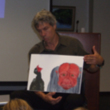Look Up!: : the story of the first woman astronomer
(Book)
JB LEAVITT H
1 available
Copies
| Location | Call Number | Status |
|---|---|---|
| Shirlington - Kids Biography | JB LEAVITT H | Available |
Description
More Details
Notes
Also in this Series
Published Reviews
Booklist Review
When Henrietta Leavitt graduated from Radcliffe College in 1892, women were not seen as potential scientists. Still, she accepted a rather tedious job measuring the positions and sizes of stars in images photographed using the Harvard College Observatory telescope. Besides measuring and note-taking, she analyzed the records on certain stars that appeared to blink on and off. Her discovery that the time between blinks indicated both the star's brightness and its distance from Earth led to the realization that the universe was much larger than previously thought. Focusing on the life of the mind, the text is contemplative and the illustrations are understated. In childhood, Leavitt is shown gazing at the night sky; as an adult, her most active endeavor is a sedate walk. The writing celebrates her achievement, though, and the lovely artwork, set outdoors at night or indoors by day, includes yellow, tan, and white elements that are luminous within the dimly lit scenes. A worthy picture book with informative back matter that will help children understand Leavitt's challenging times as well as her achievement.--Phelan, Carolyn Copyright 2010 Booklist
Publisher's Weekly Review
Burleigh (George Bellows: Painter with a Punch!) investigates a woman astronomer who made a significant discovery in the 1900s when most women in her field "were human 'computers.' Their job was to record. And measure. And calculate. The women were expected to 'work, not think.' " Henrietta Leavitt didn't comply. Working at the Harvard College Observatory, she closely observed photographs of stars and uncovered a way to measure their true brightness, paving the way for others to measure even greater distances to the stars. Burleigh's narrative is simultaneously succinct, descriptive, and appealing: "When she closed her eyes, she could still see the star dots, dancing across the inside of her eyelids." Working in his familiar warm, glowing style, Colon (Annie and Helen) uses colored pencils and watercolors to create feathery-textured illustrations. Some images of Leavitt at work are rendered in muted beiges and greens, which make the night sky scenes shine all the brighter with their vivid royal blues and brilliant points of white light. An afterword about Leavitt and her discovery, glossary, bibliography, and other resources round out this attractive picture-book biography. Ages 4-8. (Feb.) (c) Copyright PWxyz, LLC. All rights reserved.
School Library Journal Review
Gr 2-4-Scientific biographers face an unenviable challenge: How does one convey the excitement and impact of an individual's discovery when all but a tiny minority of the audience know nothing about the subject's field of study? In writing about Henrietta Leavitt, a pioneering female astronomer whose contributions revolutionized methods for measuring large distances in space, Burleigh approaches the problem with exclamation points. He drops in on Leavitt from inquisitive youth to "human computer" calculating data in a male-dominated lab and takes several carefully worded pages to outline the basics of her remarkable discovery. His success in delivering the science with clarity and brevity deserves admiration. But barring prior interest in the night sky, readers may find the punctuation-and sporadic third-person questions-attempts to manufacture passion and curiosity not entirely engendered by a narrative that reveals little about the subject beyond her most influential work. The textures and geometric composition of Colon's distinctive colored pencil and watercolor illustrations radiate with a diverse palette that encompasses warm, neutral interiors and fresh, vivid celestial views. The full-page scenes and star-filled spots, though awkwardly dispersed throughout the text, evoke the thrilling mystery and beauty of astronomy. Back matter includes an afterword that fills in biographical details, such as dates and places, not mentioned in the main text.-Robbin E. Friedman, Chappaqua Library, NY (c) Copyright 2013. Library Journals LLC, a wholly owned subsidiary of Media Source, Inc. No redistribution permitted.
Horn Book Review
Burleigh brilliantly imagines details in the life and work of Henrietta Leavitt, a turn-of-the-twentieth-century astronomer whose studies as a "computer" of star patterns at the Harvard College Observatory led to significant discoveries. Paired with Colsn's striking illustrations of the serious and scholarly Leavitt, this is a rich portrayal of a woman's determination to follow her unlikely dream of scientific exploration. Websites. Bib., glos. (c) Copyright 2013. The Horn Book, Inc., a wholly owned subsidiary of Media Source, Inc. No redistribution permitted.
Kirkus Book Review
Burleigh weaves imagination and information to sketch the life of a female scientist and illuminate her achievements. Henrietta Swan Leavitt, born in 1868, was a graduate of Oberlin and of the school that would become Radcliffe. Her interest in astronomy led her to work for many years in the Harvard Observatory. Although women were prevented from taking part in many facets of academic exploration, Leavitt made a major discovery within the parameters of her assigned work. Though little is known of his subject's life, Burleigh posits an early interest in the stars that may help to engage young listeners. The conversational text moves quickly, taking readers from dreamy child to dedicated researcher. Sophisticated vocabulary and complex concepts, as well as the variety of supplementary information Burleigh provides, from quotations about the stars to brief information about other female astronomers, suggest that this would be most useful as supplemental material in a science curriculum. Coln's watercolor, pen and pencil illustrations extend the text as, for example, when the sideways glances of Leavitt's college peers effectively convey just how unusual her interests and accomplishments were for the time. They also capture the fascination and beauty of starlight, which seems almost to twinkle at times. The current educational emphasis on science, technology, engineering and math (aka STEM) will likely increase interest in biographies about women's achievements in these fields. An artful and inspiring effort. (quotations, afterword, author's note, glossary, Internet resources, bibliography) (Picture book/biography. 7-9)]] Copyright Kirkus Reviews, used with permission.
Booklist Reviews
When Henrietta Leavitt graduated from Radcliffe College in 1892, women were not seen as potential scientists. Still, she accepted a rather tedious job measuring the positions and sizes of stars in images photographed using the Harvard College Observatory telescope. Besides measuring and note-taking, she analyzed the records on certain stars that appeared to blink on and off. Her discovery that the time between blinks indicated both the star's brightness and its distance from Earth led to the realization that the universe was much larger than previously thought. Focusing on the life of the mind, the text is contemplative and the illustrations are understated. In childhood, Leavitt is shown gazing at the night sky; as an adult, her most active endeavor is a sedate walk. The writing celebrates her achievement, though, and the lovely artwork, set outdoors at night or indoors by day, includes yellow, tan, and white elements that are luminous within the dimly lit scenes. A worthy picture book with informative back matter that will help children understand Leavitt's challenging times as well as her achievement. Copyright 2012 Booklist Reviews.
Publishers Weekly Reviews
Burleigh (George Bellows: Painter with a Punch!) investigates a woman astronomer who made a significant discovery in the 1900s when most women in her field "were human ‘computers.' Their job was to record. And measure. And calculate. The women were expected to ‘work, not think.' " Henrietta Leavitt didn't comply. Working at the Harvard College Observatory, she closely observed photographs of stars and uncovered a way to measure their true brightness, paving the way for others to measure even greater distances to the stars. Burleigh's narrative is simultaneously succinct, descriptive, and appealing: "When she closed her eyes, she could still see the star dots, dancing across the inside of her eyelids." Working in his familiar warm, glowing style, Colón (Annie and Helen) uses colored pencils and watercolors to create feathery-textured illustrations. Some images of Leavitt at work are rendered in muted beiges and greens, which make the night sky scenes shine all the brighter with their vivid royal blues and brilliant points of white light. An afterword about Leavitt and her discovery, glossary, bibliography, and other resources round out this attractive picture-book biography. Ages 4–8. (Feb.)
[Page ]. Copyright 2012 PWxyz LLCSchool Library Journal Reviews
Gr 2–4—Scientific biographers face an unenviable challenge: How does one convey the excitement and impact of an individual's discovery when all but a tiny minority of the audience know nothing about the subject's field of study? In writing about Henrietta Leavitt, a pioneering female astronomer whose contributions revolutionized methods for measuring large distances in space, Burleigh approaches the problem with exclamation points. He drops in on Leavitt from inquisitive youth to "human computer" calculating data in a male-dominated lab and takes several carefully worded pages to outline the basics of her remarkable discovery. His success in delivering the science with clarity and brevity deserves admiration. But barring prior interest in the night sky, readers may find the punctuation-and sporadic third-person questions-attempts to manufacture passion and curiosity not entirely engendered by a narrative that reveals little about the subject beyond her most influential work. The textures and geometric composition of Colón's distinctive colored pencil and watercolor illustrations radiate with a diverse palette that encompasses warm, neutral interiors and fresh, vivid celestial views. The full-page scenes and star-filled spots, though awkwardly dispersed throughout the text, evoke the thrilling mystery and beauty of astronomy. Back matter includes an afterword that fills in biographical details, such as dates and places, not mentioned in the main text.—Robbin E. Friedman, Chappaqua Library, NY
[Page 91]. (c) Copyright 2012. Library Journals LLC, a wholly owned subsidiary of Media Source, Inc. No redistribution permitted.Reviews from GoodReads
Citations
Burleigh, R., & Colón, R. (2013). Look Up!:: the story of the first woman astronomer . Simon & Schuster Books for Young Readers.
Chicago / Turabian - Author Date Citation, 17th Edition (style guide)Burleigh, Robert and Raúl Colón. 2013. Look Up!:: The Story of the First Woman Astronomer. New York: Simon & Schuster Books for Young Readers.
Chicago / Turabian - Humanities (Notes and Bibliography) Citation, 17th Edition (style guide)Burleigh, Robert and Raúl Colón. Look Up!:: The Story of the First Woman Astronomer New York: Simon & Schuster Books for Young Readers, 2013.
Harvard Citation (style guide)Burleigh, R. and Colón, R. (2013). Look up!:: the story of the first woman astronomer. New York: Simon & Schuster Books for Young Readers.
MLA Citation, 9th Edition (style guide)Burleigh, Robert, and Raúl Colón. Look Up!:: The Story of the First Woman Astronomer Simon & Schuster Books for Young Readers, 2013.





























